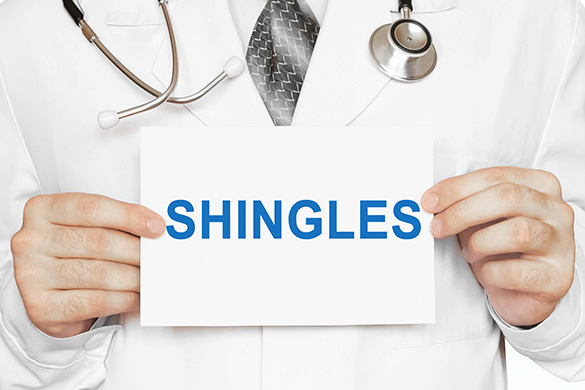How Long Does Shingles Last – Shingles are one of the most common diseases in the United States. As for the Center for Disease Control and Prevention, the United States records more than 3,000,000 cases of fingers each year.
As per the statistics and researchers, around 33% of the population of the United States of America is going to get shingles once in their lifespan. There is a high probability that people who never develop chickenpox in their life might get shingles directly because the vaccine to prevent chickenpox also contains the virus of chickenpox.
Shingles are a very painful disease. Even though it does not take The life of a person, it can cause very difficult days during the shingles attack. Because of all that, the Centers for Disease Control and Prevention recommend everyone above the age of 60 get the vaccine for shingles.
If you are also on edge about getting shingles, or you are already suffering from shingles, and you are wondering how long do shingles last? Then, you are at the right place because we are going to discuss it now.
What are Shingles?
Let’s clear the basics first. It Is a viral infection that can affect around 33% of adults in the United States, as per the Centers for Disease Control and prevention. It is more common in adults over the age of 60 than youngsters.
It is caused by the same virus, which can cause chickenpox, and if you have ever been diagnosed with chickenpox, this means you can get shingles if you are not vaccinated for the same.
Shingles Symptom Timeline
Let’s first understand the timeline of shingles. There are a few ways, or I say signs which you can spot early, then the attack of shingles. Usually, people ignore those signs, but if you are well aware enough, you can easily spot them.
If you can spot the signs early enough, then you can treat them, which will lower the intensity of the symptoms and severity.
Around five to seven days before the shingles attack, you might experience a rash or a little bit of sensitivity in the skin caused by the same virus.
Apart from that, if you are feeling uncomfortable with your skin or you are experiencing hot skin, these are the directions for an upcoming single attack. A lot of people have also experienced regular irritation and itching around the area of the skin where the shingle is going to attack next.
At the same time, numbness and tingling are also very common early signs of the shingles attack.
The main timeline of a shingles attack
Till now, we have only talked about the early signs of the attack of shingles. Now let’s take a look at the next and the main timeline of the attack of shingles.
As soon as you start seeing the signs of a shingles attack, a red rash will form around the sensitive area where the shingles are going to attack. It might take around one to five days to develop the rash.
Within ten days of seeing the signs, that sensitive area will develop fluid-filled blisters, and they will lose before drying up. You should keep checking all these symptoms and the timeline of these symptoms.
Within 14 days of seeing the early signs of a shingles attack, scabs will form on the skin, and it will be the first sign of healing.
During that time, you might develop a few symptoms according to the sensitivity of your skin and the severity of the rash.
A lot of people complained about having chills and fever during the shingles attack, which is common as your body starts fighting the virus, which could be spreading throughout the body.
Fatigue and headaches are other common symptoms during the shingles attack, and you should not be worried about these symptoms as they go away with simple medicine.
It is also possible that during the shingles attack, you might develop sensitivity to light which will be a temporary condition. Even so, the damage might become permanent if the singer’s attack is near the eyes.
The overall process of a shingles attack is going to take around 14 to 20 days. A lot of things are going to impact the timing of the attack. Your awareness of the disease is going to be the biggest influence on the overall timeline of the shingles attack.
Long Term Effects of Shingles
Now let’s take a look at the long-term effects of the shingles attack. Usually, it does not leave any long-term effects, but there is a possibility, and we cannot deny it.
Postherpetic Neuropathy Is the most complicated of having singles. During the Postherpetic neuropathy, the feeling of pain in the nerves where the shingle is going to attack might become permanent.
The condition is more common in people who are already suffering from different diseases, including diabetes.
As per the Centers for Disease Control and Prevention, around 13% of people who get diagnosed with shingles might experience Postherpetic neuropathy.
It can be very difficult to treat, and the pain can last years before you will be able to treat it permanently.
Apart from that, there is a possibility that you might get a bacterial infection on the skin on the rash side. But the probability is very low.
A small number of people have also experienced hearing loss, facial paralysis, and loss of taste after getting shingles. That is why doctors recommend everyone not leave shingles on their own.
Treatment Options for Shingles
Now I wonder how I can get treated for shingles. There is a huge number of people who might not experience severe pain due to shingles, and they mostly ignore having the disease, which makes everything worse.
If you visit your doctor for shingles, your doctor might recommend you get an antiviral drug that could help you improve your symptoms and clear the virus from your system.
Apart from that, your doctor might recommend you over the counter or prescription drugs which will be anti-inflammatory drugs in order to reduce the swelling and pain.
Your doctor will take a look at all of your symptoms, and you will be prescribed the medication after that.
At the same time, your doctor might ask you to perform a specific start that will manage your symptoms of shingles.
For example, you might be asked to get enough sleep and rest, which will give enough time to your immune system to fight against the virus. You should also avoid doing any hard work.

You must be using a wet compress on the itchy and inflamed skin. It will give you relief from the pain and itchiness. At the same time, you should also try to have a stress-free life.
Medication and deep breathing exercises can also help you lower the pain levels and improve your overall symptoms. Kindly do not wear tight-fit clothes and unnatural fabrics.
No matter what, you should never scratch the rash and blister. If you scratch the rash or blisters, it can further expand the infection and, of course, several complications.
Takeaways
Shingles are among the most painful diseases in the world. Even though the pain lasts only a few days, it can create very hard days. That is why most of the health experts in the world believe that you should be aware of the disease.
As per the Centers for Disease Control and Prevention, around 3 million people in the United States of America get affected by the shingles attack.
Usually, it starts as a rash around five to seven days before the attack of singles. You will feel redness on the skin and a bit of itchiness. After five or seven days, it will develop blisters, and you might experience a lot of symptoms such as irritation and itching.
Within 10 to 14 days, scabs will form on the skin, which is the first sign of healing. During that time, you might also experience a few symptoms, including chills and fevers.
A lot of people have also claimed to have fatigue, headache, and nausea during the actual attack of shingles. The overall timeline of early signs to aftermath is around 14 to 20 days.
In the above globe, we have also talked about the treatment and long-term effects of shingles. The Centers for Disease Control and Prevention, around 13% of people who get diagnosed with singles might develop long-term effects.
Can I prevent shingles?
There is no permanent solution that can help you prevent shingles. Even though the Centers for Disease Control and Prevention recommend everyone to get a vaccine for Shingles, that also has 90% effectiveness. There is no complete solution that can help you prevent shingles.
Are shingles contagious?
No, shingles are not contagious, but you should be very careful if you have never been diagnosed with chickenpox. Those who have already been diagnosed with chickenpox do not have to worry about it.
